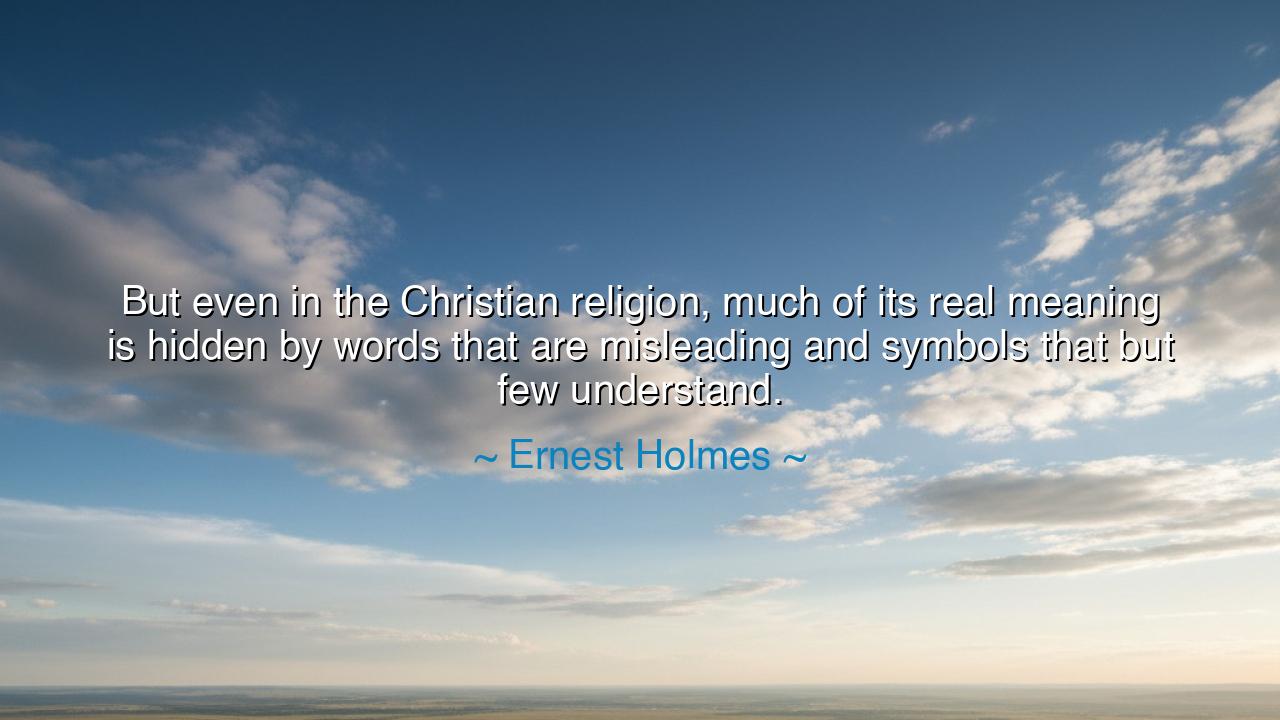
But even in the Christian religion, much of its real meaning is
But even in the Christian religion, much of its real meaning is hidden by words that are misleading and symbols that but few understand.






In the vast and ever-expanding tapestry of human understanding, faith and religion have played central roles in shaping the lives and destinies of billions. Yet, as the philosopher and spiritual teacher Ernest Holmes poignantly observes, “But even in the Christian religion, much of its real meaning is hidden by words that are misleading and symbols that but few understand.” These words invite us to look beyond the surface, to recognize that while religious texts and symbols are often revered as sacred, their true meaning is often obscured by layers of language and tradition. Holmes speaks not to diminish the value of faith, but to call us toward a deeper, more authentic understanding of the spiritual truths that lie hidden beneath the surface of conventional teachings.
In the Christian tradition, as in many other faiths, the teachings of Jesus Christ are framed in parables, symbols, and language that have often been misunderstood or distorted through the ages. The words of the scriptures, passed down through centuries, are sometimes misleading, not because of their inherent truth, but because the context in which they were spoken has changed, and their deeper meanings have been clouded by the interpretation of each successive generation. Ernest Holmes, in his reflection, suggests that the true message of Christianity has often been buried beneath the weight of dogma, rituals, and doctrines that serve to divide rather than unite. The Christ that lived and preached love, compassion, and forgiveness has sometimes been lost in the layers of institutionalized religion that seek control rather than liberation.
The Gospels themselves are a rich source of metaphor, with Jesus’ parables often conveying deep spiritual truths that transcend the literal. Yet, over time, these parables have been transformed into rituals and commands, leading many to see the teachings of Jesus not as a universal message of love and unity, but as a set of rules to be followed. The symbol of the cross, which to the early Christians represented sacrifice and redemption, has, for some, become a ritualistic object devoid of its deeper spiritual significance. Holmes’s observation challenges us to look beyond the external symbols and to rediscover the inner wisdom of the faith—wisdom that speaks not only to Christians but to all of humanity.
Consider the example of St. Francis of Assisi, who lived a life that mirrored the deep truths of Christ’s teachings. In his simplicity and devotion, Francis rejected the superficial trappings of religion and embraced the spiritual essence of Christ’s message: to love all beings, to serve without expectation, and to see God in the world around us. His life was a living example of how one might transcend the limitations of religion as an institution and embrace the deeper, more universal truths that it points toward. Francis did not cling to symbols or rituals but sought to embody the spiritual teachings of Christ in his own life, recognizing that the meaning of religion lies in its ability to guide us toward a deeper connection with God, not in the rituals we perform.
In the same vein, Holmes suggests that in Christianity, as in all religions, the true message lies not in the words spoken or the symbols used, but in the spirit that animates them. Jesus did not teach through laws, but through compassionate actions, through the way He loved, healed, and forgave. These actions were not merely symbolic; they were expressions of a deeper truth that transcended the limitations of language. Holmes calls us to rediscover this truth—not in the church pews or in the words of a preacher, but in our own hearts and in the way we choose to live our lives in accordance with these timeless teachings.
The lesson in Holmes’ words is not one of rejection, but of rediscovery. It is a reminder that religion, at its core, is a path to understanding, not a set of rules to control or divide. The symbols and rituals may be important, but they are only vessels that carry deeper spiritual meanings. We must not be bound by the shallow interpretations of faith handed down to us, but must strive to understand the true essence of these teachings. This requires not just intellectual study, but a deep spiritual inquiry—a willingness to look beyond the surface and to seek the truth that lies hidden beneath.
In our own lives, let us be mindful of how we approach religion and spirituality. Let us not become lost in the rituals and symbols, but let us look for the deeper meaning behind them. Let us trust our hearts to guide us toward the universal truths of love, compassion, and peace that transcend religious boundaries. Ernest Holmes’s call is one to live with awareness—to challenge the misleading interpretations of faith and to seek a deeper connection with the divine, one that is rooted in personal experience and inner truth. In this way, we can embrace the true meaning of religion, a meaning that connects us all and lifts us up to a higher, more unified understanding of the world and our place within it.






AAdministratorAdministrator
Welcome, honored guests. Please leave a comment, we will respond soon